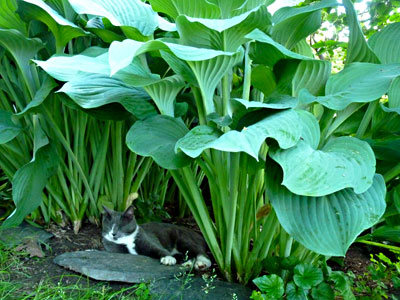 |
| Hostas are edible when young and sheltering when older. English photo. |
By Ansel Oommen
Hostas – count on them to liven up your shady patches, borders and sidewalks in ways no other plant can. With an endless array of low maintenance choices, they offer an artist’s palette of groundcovers. Yet, despite being so familiar, these garden fixtures boast a well-kept secret: They’re perfectly edible!
In fact, the Japanese have been eating hostas safely for centuries. Known as urui, they’re commonly boiled, fried in tempura or eaten raw. With a flavor reminiscent of lettuce and asparagus, they can easily be substituted in salads. Ancestry doesn’t hurt either: Hostas belong to the family Asparagaceae, known for other famous relatives such as agave (think tequila), yucca, and of course, the namesake asparagus.
To harvest, select shoots that are young and tender, as older leaves are bitter. It’s best to do this in the morning when the plant is most succulent. Leaves can be sautéed, added to stir fry, or used in wheat-free sandwich wraps. When in doubt, just treat them like any other leafy green. Interestingly enough, hosta flowers are also edible (albeit a bit bland), and these can be used as colorful garnishes.
While they are indeed safe for human consumption, hostas are toxic to cats and dogs. A common trick to prevent accidental munching is to spray the foliage with a lemon juice mixture.
So go ahead, try hostakopita, hosta alfredo, hostas in whatever pasta you please – just be sure to get the leaves before the snails do!
Looking for more seasonal recipes? Sign up for MOFGA’s Local and Organic Kitchen Newsletter.
